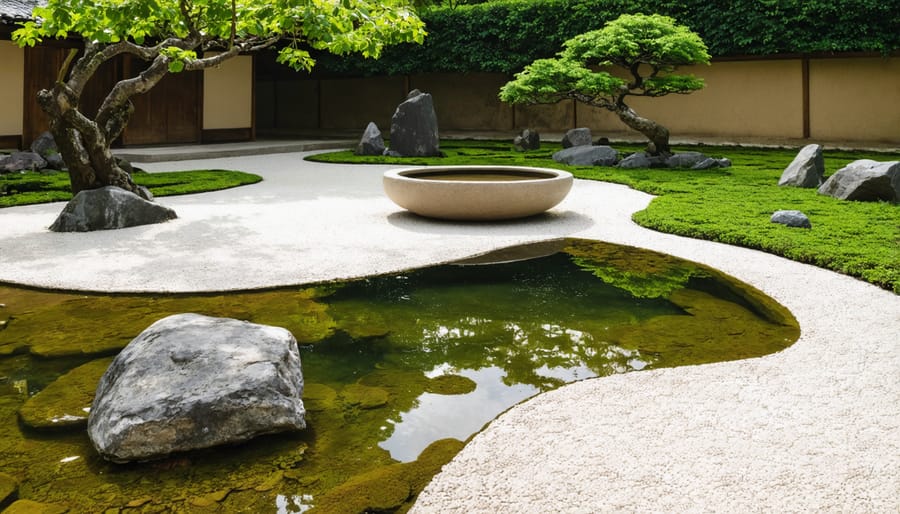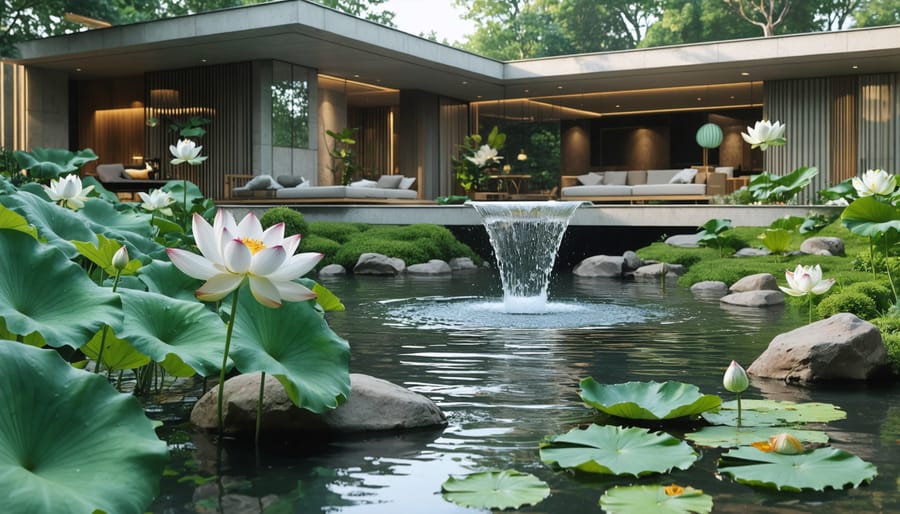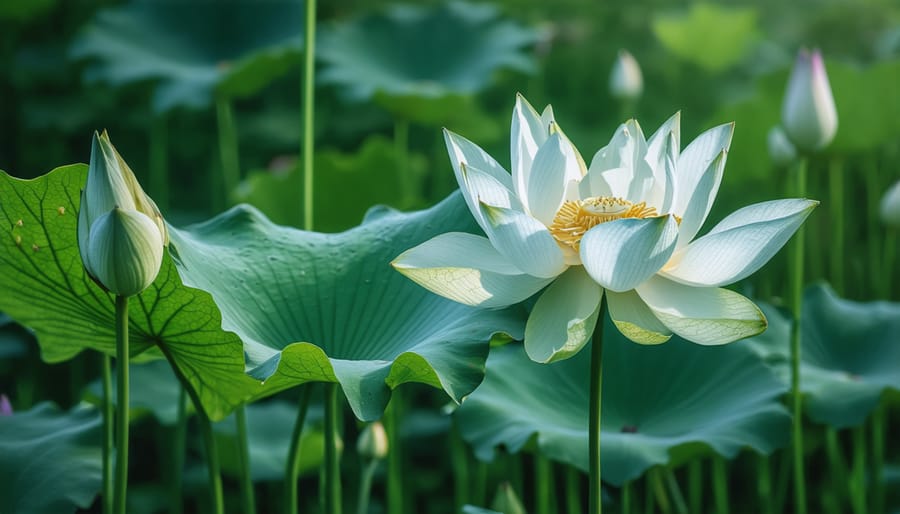
Sacred Water Gardens: Creating Your Own Spiritual Oasis at Home
Water flows through every sacred tradition, carrying centuries of spiritual wisdom and cultural reverence. From the holy Ganges to Native American blessing ceremonies, ancient water garden rituals continue to shape our understanding of this life-giving element. As the foundation of all existence, water transcends religious boundaries, speaking a universal language of purification, healing, and renewal.
Modern science echoes what indigenous peoples have known for millennia: water possesses unique properties that influence life at molecular levels. Its ability to dissolve, transform, and sustain makes it both practically essential and spiritually significant. In sacred spaces worldwide, the sound of flowing water creates sanctuary, while still pools invite reflection and meditation.
Today, as environmental challenges threaten water sources globally, recognizing water’s sacredness isn’t just spiritually meaningful—it’s ecologically imperative. Whether in grand temples or humble home gardens, honoring water as sacred connects us to an ancient wisdom that may hold keys to our sustainable future. This understanding bridges traditional reverence with contemporary environmental stewardship, reminding us that protecting water means preserving life itself.
The Ancient Legacy of Sacred Water Gardens
Sacred Waters Across Cultures
Throughout history, water has held profound spiritual significance across diverse cultures and religions. Ancient Egyptians revered the Nile as the source of life, incorporating water features in their temple gardens to honor their deities. Similarly, Japanese water garden traditions reflect deep spiritual connections, with koi ponds and waterfalls serving as symbols of purification and harmony.
In Hindu culture, the Ganges River represents divine presence, while sacred temple pools offer spaces for spiritual cleansing and meditation. Buddhist traditions incorporate water as a symbol of clarity and enlightenment, often featuring gentle fountains and reflection pools in their monastery gardens.
Native American cultures have long honored natural springs and waterways as sacred gathering places, viewing them as connections to the spirit world. In Christianity, water symbolizes purification and renewal through baptism, while Islamic gardens traditionally feature four-part water channels representing the rivers of Paradise.
These cultural practices inspire modern water gardeners to create their own meaningful spaces. Whether it’s a small meditation fountain or a larger pond with sacred lotus flowers, incorporating these ancient traditions helps create a spiritual connection to water in our own backyards.

Traditional Design Elements
Sacred water gardens traditionally incorporate several key design elements that work together to create a sense of tranquility and spiritual connection. The most fundamental feature is the use of circular or flowing shapes, which represent the endless cycle of life and spiritual journey. These organic forms are often seen in pond edges, walkways, and surrounding plantings.
Stone plays a crucial role in sacred water gardens, with carefully placed rocks and boulders serving as both symbolic mountains and practical focal points. Natural stone benches or meditation spots are positioned to offer quiet contemplation areas where visitors can sit and connect with the water’s energy.
Water movement is another essential element, typically achieved through gentle waterfalls or fountains. The sound of flowing water not only masks unwanted noise but also creates a meditative atmosphere that helps calm the mind and spirit. Many sacred gardens incorporate three-tier fountains, representing heaven, earth, and humanity.
Traditional sacred water gardens also feature specific plants known for their spiritual significance. Lotus and water lilies are particularly important, as they symbolize enlightenment and purity in many cultures. These aquatic plants are often complemented by sacred trees like Japanese maples or weeping willows, which provide shade and create a sense of enclosure.
Bridges and stepping stones are commonly used to create intentional pathways, encouraging mindful movement through the space. These elements symbolize the journey across spiritual waters and the connection between different states of being.
Designing Your Sacred Water Garden

Essential Elements and Symbolism
Water’s sacred essence is expressed through several key mythical water garden elements that each carry profound spiritual meaning. The most fundamental is flowing water, symbolizing the continuous movement of life and spiritual energy. This dynamic element represents purification and renewal, washing away negative energies while bringing fresh vitality to the space.
Stones and rocks placed around water features represent stability and permanence, creating a grounding effect that balances the fluid nature of water. Natural materials like bamboo and wooden bridges serve as connections between the physical and spiritual realms, offering pathways for contemplation and transition.
Aquatic plants, particularly lotus and water lilies, are powerful symbols of enlightenment and spiritual growth. Rising from murky depths to bloom in pristine beauty, they remind us of our own potential for transformation. Fish, especially koi, represent prosperity, perseverance, and good fortune, their graceful movements adding life and energy to the sacred space.
The sound of moving water, whether from a gentle fountain or cascading waterfall, creates a peaceful atmosphere that promotes meditation and spiritual connection. This auditory element helps mask outside noise, creating a sanctuary for reflection and inner peace.
Plant Selection and Placement
When selecting plants for your sacred water garden, choose species that carry deep spiritual significance across cultures. Lotus flowers, revered in Buddhist and Hindu traditions, symbolize enlightenment and purity as they rise from muddy waters. Water lilies, particularly the white varieties, represent peace and tranquility, making them perfect centerpieces for meditation spaces.
Consider incorporating rushes and cattails along the edges, as these plants were traditionally used in purification rituals by many indigenous cultures. Sacred iris, with its sword-like leaves, serves as a natural guardian and adds vertical interest to your balanced water garden ecosystem.
When placing these plants, work in odd numbers for natural harmony. Position taller plants like papyrus or bamboo on the north side to protect smaller specimens while creating a sense of enclosed sanctuary. Float-friendly plants like water lettuce can move freely, representing the fluid nature of spiritual growth.
Remember to include some marsh marigolds or Japanese sweet flag near sitting areas – their gentle movement in the breeze creates a calming effect perfect for contemplation. For evening meditation, consider night-blooming varieties like tropical water lilies, whose flowers open at dusk to create magical moonlit reflections on the water’s surface.

Water Features and Flow
Water movement in sacred gardens goes beyond mere aesthetics – it’s about creating an environment that speaks to the soul. The gentle splash of a waterfall or the musical trickle of a stream can transform your space into a sanctuary of peace and reflection.
Start by considering the natural flow patterns of water. A cascading waterfall creates a powerful, energizing presence, while a subtle bubbling fountain offers a more meditative atmosphere. The key is to match the water feature’s character with your intended spiritual practice or meditation style.
For a harmonious sound experience, experiment with different heights and surfaces. Water falling onto stone creates crisp, bright notes, while water flowing over smooth surfaces produces softer, more soothing tones. Multiple small drops often create more pleasing sounds than a single large stream.
Consider incorporating curved paths for water flow, as these represent the natural meandering of rivers and streams. This organic movement helps create a more authentic connection to nature’s rhythms. Position seating areas where the water sounds are clear but not overwhelming, allowing for comfortable contemplation.
Remember that water movement also serves practical purposes, helping to maintain oxygen levels and prevent stagnation. A well-designed flow system can support both the physical health of your water garden and its spiritual ambiance.
Maintaining the Sacred Space
Seasonal Care and Rituals
As the seasons change, your sacred water garden requires different types of care to maintain its spiritual essence and practical functionality. In spring, begin by gently clearing away debris and dead plant material that accumulated over winter. This is also the perfect time to divide and replant aquatic plants, blessing each new division as you place it in its new home.
Summer brings lush growth and increased evaporation. Monitor water levels regularly, topping up when needed while expressing gratitude for the life-giving properties of water. Keep an eye on algae growth, which can be managed naturally by adding floating plants that provide shade and maintain water quality.
Fall calls for preparation and protection. As leaves begin to fall, consider placing a fine mesh net over your water feature to prevent excess organic matter from accumulating. This is also the time to carefully trim back aquatic plants, thanking them for their summer beauty while preparing them for winter dormancy.
Winter requires mindful attention to preserve your garden’s sacred space. In colder regions, use a small floating heater to keep a portion of the surface from freezing completely, allowing for gas exchange and protecting any overwintering fish. This open water also serves as a vital drinking source for local wildlife, extending your garden’s blessing to the natural world.
Throughout the year, maintain a ritual of spending quiet moments by your water garden, perhaps during sunrise or sunset. These peaceful transitions offer perfect opportunities to connect with the sacred nature of water and refresh your spirit alongside your garden.
Creating Daily Connections
Creating a daily connection with your water garden can transform it from a simple landscape feature into a meaningful spiritual practice. Start your day by spending a few quiet moments near the water, perhaps during sunrise when the world is still peaceful. This morning ritual can help center your thoughts and set a positive tone for the day ahead.
Consider establishing a small meditation area near your water feature, using comfortable seating that invites regular visits. The sound of flowing water naturally helps quiet the mind, making it easier to achieve a meditative state. You might want to keep a garden journal nearby to record your thoughts, observations, and the changing seasons.
Make it a practice to tend to your water garden mindfully. Instead of viewing maintenance as a chore, approach tasks like skimming leaves or cleaning filters as opportunities for connection. As you work, express gratitude for the water’s presence in your life and its role in sustaining the life forms in and around your garden.
Create simple rituals that feel meaningful to you. This could include floating flowers on special occasions, offering prayers or intentions while adding fresh water, or simply sitting in quiet contemplation during sunset. You might also consider incorporating elements from various spiritual traditions that resonate with you, such as placing crystals near the water or creating a small altar space.
Remember that consistency matters more than complexity. Even a few minutes daily spent in conscious connection with your water garden can deepen your spiritual practice and enhance your appreciation for this sacred element.
Creating a sacred water space in your garden or home is more than just an aesthetic choice – it’s an opportunity to connect with one of nature’s most powerful elements. Throughout this journey, we’ve explored how water features can transform ordinary spaces into sanctuaries of peace and reflection. Whether you choose a small tabletop fountain, a meditation pond, or an elaborate water garden, each drop holds the potential to bring tranquility and spiritual connection to your daily life.
The benefits of incorporating sacred water elements are truly remarkable. From the gentle sound of flowing water that reduces stress and anxiety to the way it attracts wildlife and creates a living ecosystem, these features enhance both our physical and spiritual well-being. Sacred water spaces provide a focal point for meditation, prayer, or simple quiet contemplation, helping us slow down and reconnect with nature’s rhythms in our fast-paced world.
Don’t feel overwhelmed by the prospect of creating your own sacred water space. Start small if you need to, and let your space evolve naturally over time. Remember that the most important element is your intention – the conscious decision to treat water with reverence and create a space that honors its sacred nature.
As you embark on this rewarding journey, keep in mind that your sacred water feature will become more meaningful with each passing season. It will grow with you, reflect your personal spiritual journey, and provide endless opportunities for connection and reflection. Take that first step today toward creating your own sacred water space – your future self will thank you for this gift of peace and tranquility.
